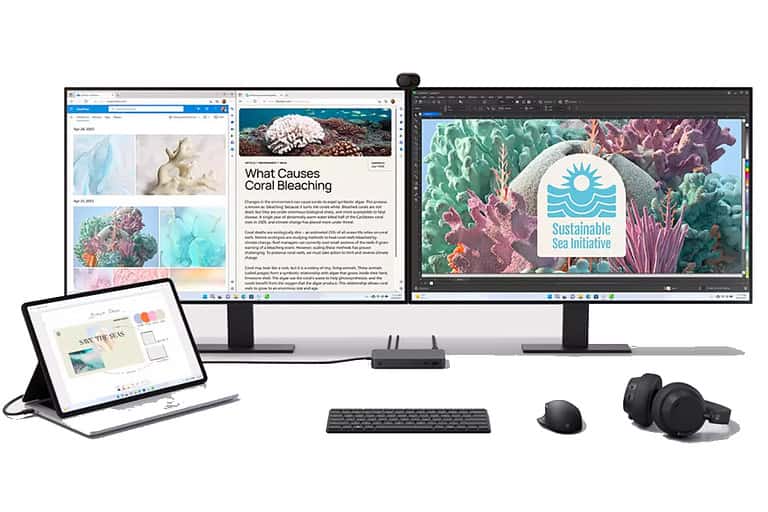Back in the spring of 2020, Microsoft was still convinced that Surface laptops could not safely handle Thunderbolt. With the introduction of the Surface Laptop 5 and the Surface Pro 9 (Intel only), that has apparently changed. Now there is even a Surface Thunderbolt 4 Dock. What has changed?
Apple has been using Thunderbolt on its MacBooks since 2011. Microsoft, on the other hand, has consistently not supported Thunderbolt for years. Now the time has finally come for Microsoft to embrace Thunderbolt as well. The USB C ports on Microsoft Surface products will get Thunderbolt 4 support. Is that because of EU legislation that you should be able to charge everything via USB C or did they have a different reason?
Versatile and secure
On its own website, Microsoft talks about more versatility in handling Surface laptops thanks to the arrival of Thunderbolt 4. Due to its high bandwidth and high speed, Thunderbolt is sometimes referred to in the media as the “one cable to rule them all.” Eliminating the Surface Connect port also means that a Surface Dock should now be compatible with laptops from other brands. The charging of laptops is now done through the USB C cable instead of the magnetic Surface Connect connector. A win-win for the consumer, in other words.
More usability is not only an improvement for the end user. It also allows Microsoft to market its dock more broadly. After all, it is suitable for all laptops that support Thunderbolt 4 or can charge via USB C. The Thunderbolt 4 support is not required, but it does help to get higher data transfer speeds. The availability of systems with Thunderbolt 4 is only going to increase. In addition, the move to Thunderbolt 4 also provides a wider range of external displays. While HDMI and DisplayPort are by far the most popular connections between device/dock and display, the range of Thunderbolt-connected monitors is slowly increasing. Thunderbolt 4 will make it possible to support 8K displays at 60Hz as well.
Microsoft also previously believed that Thunderbolt was not secure enough. However, the so-called “Thunderclap” method allowed malicious parties to steal data due to weaknesses in Thunderbolt 3’s configuration. Criticism from a Dutch Microsoft employee at the time was that attackers could steal the date stored in RAM via Thunderbolt. After all, Thunderbolt gets Direct Memory Access on the device you connect it to. However, a device running Thunderbolt 4 is protected from this line of attack, because the piece of RAM it requests is isolated from most of the system memory. This is probably the main reason why Microsoft has now added Thunderbolt 4 to its Surface Laptop 5 and Surface Pro 9 (Intel only). Also why the new dock has been created. Thunderbolt 4 is now secure.
Confusion for consumers?
With Microsoft’s move to Thunderbolt 4, it’s safe to say that this standard is now supported throughout the industry. This is not to say that all PCs have it; that is still up to the manufacturers to determine. It does ensure that it can get a bit tricky to determine which Type-C connector we are specifically dealing with. It can be difficult for users to distinguish between Thunderbolt 3, 4 and a regular Type-C. Oh yes, and there will also be USB 4, which will be offered via a Type-C connector.
In theory, this can be solved easily. After all, there are symbols for it. A lightning bolt indicates that we are dealing with Thunderbolt. Whether that’s version 3 or 4, however, it’s impossible to tell as far as we know.
We highly doubt the industry’s solving this old problem with the USB standard. So far, at least, it has not succeeded. Consider USB 3, of which there are several variants. There is even a Gen1 and a Gen2 version of USB 3.2. Standardization sounds nice, but not if it is done this way.
By the way, with the above complaint about USB standardization, we certainly don’t want to say that Microsoft’s move to Thunderbolt 4 is a bad one. On the contrary, standardization is essentially a good idea. It just needs to be done right. Experience has taught us that that’s very hard for the industry as a whole.
